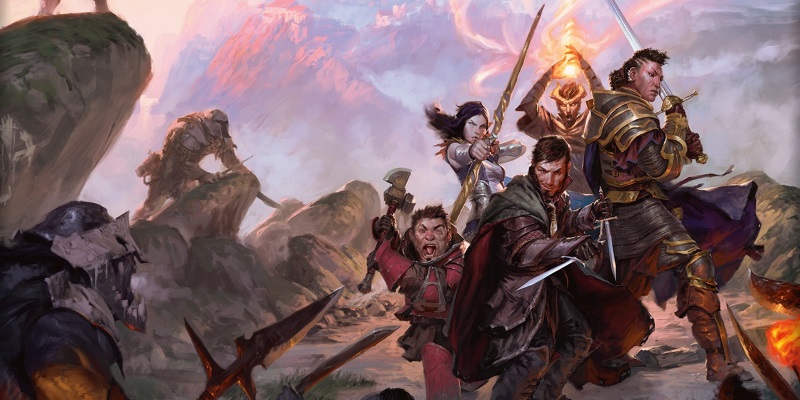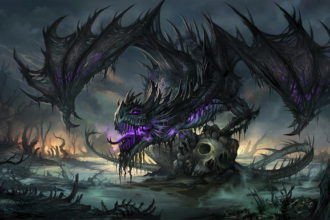Unearthed Arcana: Bard Colleges Breakdown

Welcome to Week 2 of November Madness (which might become Indefinite Madness, depending on how long they keep up with weekly UAs), in which the Dynamic Duo give us two new bard Colleges: Glamour and Whispers. These aren’t the first bard Colleges we’ve gotten from UA, either. I’ve also talked about the 5e bard class here in Tribality before, just as a baseline. Short version: bards needed more subclasses in a bad way, so I’m glad there’s been so much support.
College of Glamour
The first new College is Glamour, which is all about fey themes. Bards and fey themes got closely linked in 4e Essentials, but are a bit understated in the 5e Player’s Handbook – shared methods, but no direct link. The only thing that bugs me about the theme here is that each new College’s flavor text talks about how this College gets more respect than the one before it. I get that this is a trend that goes back through all post-initial-release writing ever – I just don’t like the subtle implication that the new one is accepted in-setting as the coolest one.
Anyway. The College of Glamour gets:
- Mantle of Inspiration, which is their new way to spend Bardic Inspiration dice. This grants both temporary hit points and an optional reaction to move toward the bard. This affects a number of allies equal to their Charisma bonus.
- Check my logic here, but this looks worlds better than any other Bardic Inspiration option we’ve seen, subclass-locked or no. 2d6 (eventually up to 2d12) hit points is a lot like turning a hit into a miss (or half damage), not for one ally, but for up to five allies. The reaction movement – since it allows targets to ignore opportunity attacks – is a free Disengage and move for the whole team, as long as the bard is somewhere they want to be. I’m flagging this one as Potentially Just Crazypants.
- Enthralling Performance takes 10 minutes to perform (so it won’t be helpful in most common adventuring situations, but could be amazing in social scenes). It charms your audience (a number of people up to your Cha modifier), makes them your biggest fans, man, might even make them fight for you (if they otherwise would), and covers its tracks so that your target doesn’t know you tried to influence them. Once per short or long rest.
- Charm immunity works here. I’m surprised at the small audience size limit, frankly – given that it’s a full performance, I would have expected it to act like a full area-effect power (along the lines of enthrall, which it loosely resembles), but… sure. Anyway, if you can set up the opportunity to use it, you’re a wrecking ball in any social scene.
- Mantle of Majesty lets you cast command as a bonus action each round for 1 minute, and anyone you currently have charmed (such as from Enthralling Performance!) autofails the save. Once per long rest.
- What you can accomplish with command is pretty narrow (and thank God for that – inventiveness in single-word imperative sentences is… aggravating), but up to ten uses without spending a spell slot? Hell yeah.
- Unbreakable Majesty is worded a little unclearly, but it lets you cast sanctuary on yourself without spending a spell slot, and anyone who makes a saving throw against it and fails (so first they have to try to attack you) falls under your sway. You gain advantage on Cha checks against them, and they suffer disadvantage on saves against your spells cast on your next turn. Once per short or long rest.
- Thematically, this one is really cool. Mechanically, I have always found sanctuary underwhelming, since it pops when the target does things that you mostly want to do in fight scenes. This pushes the Glamour bard toward healing and buffing exclusively, at least until they’ve exhausted this feature. Of course, they have the incredibly good Mantle of Inspiration to make this more interesting.
Overall, then, it’s a bard that is hyper-focused on support and would be happier to avoid combat completely. This is true of a lot of bards, in ways not found in other classes, but it’s especially on display here. I think that the long game of subclass design is that every class will have a storm-themed one, a fey-themed one, a shadow-themed one, and so on – so this feels a bit like checking off a spot on that list. My only real problem with it is thinking that Mantle of Inspiration is probably too good.
College of Whispers
I love the idea of all of these bardic colleges existing alongside one another, with one secret college hidden among them. I suspect that most campaigns don’t have time to give bards as a whole that much attention, nor to draw the PCs into their obscure yet vicious politics, but it’s still cool. Other than the existence of an evil group, there’s some room to read that into the college structures of early-edition D&D (but little if any useful guidance to the DM).
The College of Whispers is here to be manipulative and sinister. They could use a few more features that would help them pass for a member of another College. I guess you can’t have everything. But they do get:
- Venomous Blades, which lets them turn Bardic Inspiration dice into a poison damage add when they hit with a weapon, at 1:2. (That is, one die expended becomes two damage dice of the same type.)
- The theme here is just a little bit weak. Their treacherous words envenom their weapons? The one good side is that they don’t have to wander around with a detectably poisoned weapon.
- Venomous Words, which let them sow fear – and specifically paranoia – in others, with a 10-minute conversation.
- At this point, I am legitimately wondering if this article is oblique commentary on the 2016 elections.
- The paranoia effect is particularly odd, as it guides behavior with fairly loose guidance rather than “harder” rules language. Much like Enthralling Performance, this feature isn’t for combat, but to give the bard a cool, unique power in a social scene. It makes me wish that Lore and Valor had something parallel to this.
- Mantle of Whispers is straight-up awesome. It’s a great villain move, and paints this College as antiheroes-at-best. It goes like this: First, kill someone and steal their shadow. (A+, would kill and steal again.) Next, wear it as a disguise of your victim. (It puts the lotion on its skin.) Learn anything they know that is not a protected secret. (Hello, Clarice.)
- This is super cool. It avoids major mystery-breaking just by including a “don’t give up secrets” clause. It’s not incredibly impressive compared to a hat of disguise, but then hats of disguise have always been way too accessible for the level of shenanigans they bring to a campaign. I loved this feature back when it was Prototype.
- Shadow Lore is a long-duration (8 hour) charm based on perceived (though not actual) blackmail. Most of the embroidered bits that differentiate this from a charm person spell with eight times the duration are in the target’s head and inform roleplay, but don’t necessarily go deeper than that.
- It also covers its own tracks, in the sense that the target doesn’t remember why they were afraid of you. To be fair, if I remembered being terrified of someone and serving their whims but not why, that might be enough to start a fight, or at least make me a lasting enemy.
- Even so, assuming the DM has NPCs behave according to this guidance, this is probably the greatest interrogation feature I’ve yet seen in D&D.
Much like the College of Glamour, Whisper bards are pretty combat-averse, though their Bardic Inspiration powers suggest otherwise. Their features are sinister, even cruel outright, but it’s easy to fit them into a cooperative game experience. The College of Whispers is an excellent higher-fantasy rendition of Game of Thrones fan-favorite characters like Varys, Littlefinger, or Jaqen H’ghar, and that can’t help but put me in mind of Mearls’s recent comment that they’re conscious of D&D existing in a post-GoT imaginative world.
These exist a little oddly, though, alongside Lore, Valor, Swords, and Satire. The first four Colleges emphasize one particular element of a bard’s fighter-mage-rogue class mix, with Valor and Swords both covering fighter, lore covering mage and rogue, and satire covering rogue. Whispers is good for spy and assassin concepts, but it gets there in a way that has little connection with any class’s core mechanics. They’re ill-suited to any campaign that doesn’t emphasize intrigue with humanoids throughout.
One More Thing
Adjusted for context, Glamour is a better collection of features for a warlock with an Archfey patron than we see in the Player’s Handbook. The warlock has no 1:1 comparison to Mantle of Inspiration, of course, as they have no currency quite like Bardic Inspiration dice. Enthralling Performance sort of competes with Fey Presence – both are shut out by immunity to the charmed condition, and thematically they reflect the same idea about the fey. Bards sure wish they had misty step to they could fake misty escape; oh right, Magical Secrets. (A short-range teleport is one of the world’s great all-purpose tools.) My distaste for Beguiling Defenses runs deep, as it is immunity-plus; Mantle of Majesty is more interesting, if not more powerful. Dark Delirium is pure and simple crowd control, but has only tenuous thematic roots, while Unbreakable Majesty basically reinvents Fey Presence’s concept as a top-end feature.
Okay, a second additional thing. Since I’ve been writing so much about the Seelie and Unseelie lately, it seems to me that the College of Whispers is a great skin for an Unseelie bard.
The overall usefulness of these subclasses depends entirely on the stories the DM runs and the inventiveness the player shows in using these powers. Both of them need more spotlight time than the other four Colleges, just to use their features – Glamour has to do a 10-minute set, while Whispers needs time to get the paranoia train rolling. Boy howdy do they have some juicy thematic elements, though. I would play either one and expect to have an interesting time. But man, are those Bardic Inspiration features weird.


